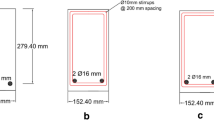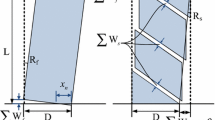Abstract
After a brief review on the concrete shear strength mechanisms, two very reliable expressions for predicting the shear strength of beams without transverse reinforcement are reported: the one proposed by Bažant and Kim [7], which is valid for Normal strength Concrete (NSC) beams, and the other recently proposed by the authors, which is valid for High Strength Concrete (HSC) beams. Hence a summary of a shear strength model for beams with stirrups is provided, which was derived [27] on the basis of the Bažant and Kim expression and therefore is adequate only for NSC beams.
On the basis of the expression obtained for HSC without stirrups and of the model already proposed for NSC with stirrups, a shear strength expression for HSC beams with stirrups is derived. The obtained expression is applied to an experimental program of 116 HSC beams with stirrups, and is found to predict the test results better than ACI Code [1], Eurocode [12] and CEB/FIP Model Code [9].
A design formula is hence proposed, which is adequately conservative and accurate.
A design example of a HSC beam with stirrups is carried out, and the various design expressions previously considered are compared.
Résumé
Après une brève revue des mécanismes de résistance au cisaillement, deux expressions très fiables prévoyant la résistance au cisaillement de poutres sans armure transversale sont rapportées: l'une proposée par Bažant et Kim [7], valable pour les poutres en béton ordinaire, l'autre récement proposée par les auteurs, valable pour les poutres en béton à haute performance. Le résumé d'un modèle de résistance au cisaillement est fourni pour les poutres avec arçons, déduit [27] à partir de l'expression de Bažant et Kim et donc adéquat seulement pour les poutres en béton ordinaire avec arçons.
En se basant sur l'expression obtenue pour les poutres en béton à hautes performances (BHP) sans arçons et sur le modèle déjà proposé pour les poutres en béton ordinaire avec arçons, on traouve une expression pour les poutres en BHP avec arçons. L'expression ainsi obtenue est appliquée à un échantillon expérimental de 116 poutres en BHP avec arçons, et s'avère plus apte à prévoir les résultats expérimentaux que le Code ACI [1], l'Eurocode [12], ou le code de référence CEB/FIP [9].
Il est donc proposé pour ce projet une expression à la fois traditionnelle et précise. Un exemple d'étude de poutre en BHP avec arçons est exposé et les différentes expressions déjà considérées pour le projet sont comparées.
Similar content being viewed by others
Abbreviations
- A s :
-
area of the longitudinal reinforcement
- A v :
-
area of stirrups
- C :
-
internal compression force
- I b :
-
beam action index
- I bc :
-
beam action index in critical conditions
- M b :
-
beam action contribution to the ultimate bending moment
- M c :
-
resisting bending moment
- M FL :
-
pure flexure bending moment
- M u :
-
ultimate bending moment in beams with stirrups
- M uc :
-
ultimate bending moment in beams without stirrups
- T :
-
tensile force in the longitudinal reinforcement
- V a :
-
resultant of the aggregate interlocking stresses at the crack interface
- V c :
-
shear force due to the concrete resisting contribution
- V d :
-
shear force due to the dowel action
- a :
-
shear span
- (a/d) c :
-
critical value of the shear span to effective depth ratio
- b :
-
beam width
- c :
-
concrete cover
- d :
-
beam effective depth
- d a :
-
maximum aggregate size
- f c :
-
concrete compressive cylindrical strength
- f yl :
-
yielding strength of the longitudinal reinforcement
- f yv :
-
yielding strength of the transverse reinforcement
- h :
-
beam depth
- j :
-
ratio between the internal lever arm and the beam effective depth
- k, q :
-
coefficients
- r :
-
coefficient which is the 0.05 fractile of the corresponding statistical distribution
- s :
-
stirrups spacing
- v s :
-
shear strength provided by stirrup
- v si :
-
shear strength due to stirrups inclusion
- v u :
-
shear strength of a beam with transverse reinforcement
- v uc :
-
shear strength provided by concrete
- x :
-
distance between the support and the transverse section at the ending point of the crack
- ϕ:
-
angle between the diagonal compression strut and the beam longitudinal axis
- ζ:
-
function taking into account the size effect
- ρ:
-
longitudinal reinforcement percentage
- ρ v :
-
geometrical percentage of the transverse reinforcement
- ψ:
-
stirrup effectiveness function
- meas :
-
measured
- calc :
-
calculated
References
ACI Committee 318, ‘Building Code Requirements for Structural Concrete and Commentary’, ACI 318-02/ACI 318R-02, American Concrete Institute, Detroit (2002) 443.
Adebar, P. and Collins, M.P., ‘Shear strength of members without transverse reinforcement’,Can. J. of Civil Engineering 23 (1) (1996) 30–41.
Ahmad, S.H. and Barker, R., ‘Flexural behavior of reinforced high-strength lightweight concrete beams’,ACI Struct. J. 88 (1) (1991) 69–77.
Ahmad, S.H., and Lue, D.M., ‘Flexure-shear interaction of reinforced high-strength concrete beams.’ACI Struct. J. 84 (4) (1987) 330–341.
Ahmad, S.H., Khaloo, A.R., and Poveda, A., ‘Shear capacity of reinforced high-strength concrete beams.’ACI J., Proc. 83 (2) (1986) 297–305.
Angelakos, D., Bentz, E.C. and Collins, M.P., ‘Effect of concrete strength and minimum stirrups on shear strength of large members.’ACI Struct. J. 98 (3) (2001) 290–300.
Bažant, Z.P. and Kim, J.K., ‘Size effect in shear failure of longitudinally reinforced beams’,ACI Struct. J. 81 (5) (1984) 456–468.
Cladera, A. and Mari, A.R., ‘Shear strength of reinforced high-strength concrete beams’, 6th Int. Symp. on ‘Utilization of High Strength/High Performance Concrete’, Lipsia, Germany (Jun. 2002) 205–219.
CEB/FIP Model Code 1990, First Draft, Chapters 6–14 and Appendices (1990).
Collins, M.P. and Kuchma, D., ‘How safe are our large, lightly reinforced concrete beams, slabs and footings?’,ACI Struct. J. 96 (4) (1999) 482–490.
Elzanaty, A.H., Nilson, A.H. and Slate, F.O., ‘Shear capacity of reinforced concrete beams using high-strength concrete’.ACI Struct. J. 83 (2) (1986) 290–296.
ENV 1992-1-1. Comité Européen de normalisation CEN, ‘Eurocode 2—Design of Concrete Structures—Part 1-1: General Rules and Rules for Buildings’ (1992).
Fenwick, R.C. and Paulay, T. Sr., ‘Mechanisms of shear resistance of concrete beams’,J. of Structural Division, ASCE 94 (10) (1968) 2325–2350.
Ganwei, C. and Nielsen, M.P., ‘Shear strength of beams of high-strength concrete’,Res. Rep., Department of Structural Engineering, Technical University of Denmark (Dan. Tek. Højsk. Afd. Bærende Konstr.), Ser R No. 258 (1990) 23.
Johnson, M.K. and Ramirez, J.A., ‘Minimum shear reinforcement in beams with higher strength concrete’,ACI Struct. J. 86 (4) (1989) 376–382.
Kani, G.N.J., ‘Riddle of shear failure and its solution’,ACI J. 61 (4) (1964) 441–467.
Kani, G.N.J., ‘Basic facts concerning shear failure’,ACI J. 63 (6) (1966) 675–692.
Kani, G.N.J., ‘A rational theory for the function of web reinforcement’,ACI J. 66 (3) (1969) 185–197.
Kim, J.K. and Park, Y.D., ‘Shear strength of reinforced high strength concrete beams without web reinforcement’,Mag. of Concrete Res. 46 (166) (1994) 7–16.
Kong, P.Y.L. and Rangan, B.V., ‘Studies on shear strength of high performance concrete beams’, Res. Rep. of the School of Civil Engineering, Curtin University of Technology, Perth, Australia, 1998, 298.
Mansur, M.A., Chin, M.S. and Wee, T.H., ‘Flexural behavior of high-strength concrete beams’,ACI Struct. J. 94 (6) (1997) 663–674.
Mörsch, E., ‘Reinforced Concrete. Its Theory and Application’ (Wittwer, Stuttgart, 1908) [in German].
Mphonde, A.G. and Frantz, G.C., ‘Shear tests of high- and low-strength concrete beams without stirrups’,ACI J. 81 (4) (1984) 350–357.
Narayanan, R. and Darwish, I.Y.S., ‘Use of steel fibers as shear reinforcement’,ACI Struct. J. 84 (3) (1987) 216–227.
Park, R. and Paulay, T., ‘Reinforced Concrete Structures’ (John Wiley & Sons, New York, 1975) 769.
Pendyala, R.S. and Mendis, P., ‘Experimental study on shear strength of high-strength concrete beams’,ACI Struct. J. 97 (4) (2000) 564–571.
Russo, G. and Puleri, G., ‘Stirrup effectiveness in R.C. beams under flexure and shear’,ACI Struct. J. 94 (3) (1997) 576–584.
Russo, G. and Somma, G., ‘Shear strength of high performance concrete beams’, Safety of high performance concrete structures, National Project financially supported by the Ministry of University and Scientific Research (MURST)—1997-98 (1999) 89–93 [in Italian].
Russo, G., Somma, G., Angeli, P. and Guerrini, G., ‘Shear strength analysis for normal and high-performance concrete beams’, 6th Int. Symp. on ‘Utilization of High Strength/High Performance Concrete’, Lipsia, Germany (June 2002) 553–567.
Russo, G., Zingone, G. and Puleri, G., ‘Flexure-shear interaction model for longitudinally reinforced beams’,ACI Struct. J. 88 (1) (1991) 66–68.
Sarsam, K.F. and Al-Musawi, J.M.S., ‘Shear design of high and normal strength concrete beams with web reinforcement’,ACI Struct. J. 89 (6) (1992) 658–664.
Shin, S. W., Lee, K. S., Moon, J. and Ghosh, S. K., ‘Shear strength of reinforced high-strength concrete beams with shear span-to-depth ratios between 1.5 and 2.5’,ACI Struct. J. 96 (4) (1999) 549–556.
Somma, G. and Russo, G., ‘Shear tests of high-performance concrete beams without stirrups’, 7th Europ. Conf. on Advanced Mat. and Processes, Rimini, Italy, June 2001, 10.
Tan, K.H., Teng, S., Kong, F.K. and Lu, H.Y., ‘Main tension steel in high strength concrete deep and short beams’,ACI Struct. J. 94 (6) (1997) 752–768.
Xie, Y., Ahmad, S.H., Yu, T., Hino, S. and Chung, W., ‘Shear ductility of reinforced concrete beams of normal and high-strength concrete’,ACI Struct. J. 91 (2) (1994) 140–149.
Yoon, Y., Cook, W.D. and Mitchell, D., ‘Minimum shear reinforcement in normal, medium and high-strength concrete beams’,ACI Struct. J. 93 (5) (1996) 576–584.
Author information
Authors and Affiliations
Rights and permissions
About this article
Cite this article
Russo, G., Somma, G. & Angeli, P. Design shear strength formula for high strength concrete beams. Mat. Struct. 37, 680–688 (2004). https://doi.org/10.1007/BF02480513
Received:
Accepted:
Issue Date:
DOI: https://doi.org/10.1007/BF02480513




